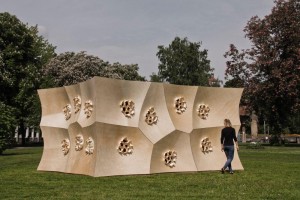Photo: HygroSkin-Meteorosensitive Pavilion, by Achim Menges (2012)
http://www10.aeccafe.com/blogs/arch-showcase/2013/09/17/hygroskin-meteorosensitive-pavilion-in-orleans-france-by-achim-menges-architect/
Manuel DeLanda discuss the bases of Gilles Deleuze thinking of morphogenesis theory and some contributions of Spinoza and Guatarri to this theme.
DeLanda starts explaining the way of thinking of the western philosophers that matter is only defined by external agents and that matter is just a infertile element, a receptacle in which outside forces will construct it shape. According to DeLanda this way of thinking can be seen since the creationism thinking, in which God, an outside person, thinks a specific and final form in which later some matter will be applied. Classical philosophers and classical physics continued this way of thinking, although the last ones began a small but important break on this way of thinking, and endow matter with some spontaneous behavior, like Inertia for instance, but they still reduce the variability and richness of material expression to the concept of mass and studied simple material systems where spontaneous self-generation of form does not occur, and so, the self-generation of form continued to have a lower importance.
But not every western philosopher were not concerned with the transcendental agency that interfere on the morphogenism, and according to DeLanda, Deleuze was one of them. He starts giving some examples of self-generating forms that show that materials have a great importance on the final form that they will have, and that the stable state of matter is the simplest type of immanent action of morphogenesis, because material is organizing itself to become stable using last energy from the enviroment. The two examples are the bubble of soup which appears naturally when the molecules of soup find it minimal surface, or sharp edges polygons, which appear when molecules of salt find its minimal surface shape in an especific circustance. Deleuze uses the therm “Divergent Actualization” of the english philosopher Henri Bergson to explain this. Henri didn’t agree with the current philosophers that had this idea of time as a linear thing, and so the future would be determined by the past. Henri thought that the future is open ended. Deleuze aplied this on his theory saying that external agents continue to interfere in the final shape of matter (the size of the bubble or the dimensions of the rock), but matter itself has this form-finding tendency.
Deleuze applied his morphogenism and form-finding theory to other realms of knowledge. In the empryology he explain that the division of the egg occur because of the the augmentation of free surfaces, with stretching of cellullar layers and invagination by folding. These Thermo dynamics way of thinking could explain that the DNA actually does not act on a inertial matter, but tease the form from an active matter. In geology, mountais made of sedimentary rocks are formed by actualization of layers of small pebbles, in which they form homogeneous layers (sorting – the begining) and then by water activity became the rock (consolidation – the end). Granite is formed by cooling magma which organizes itself based on time of cooling and became strong. Species could be explained by the slow accumulation of genetic materials and Social classes could be explained by the self organization of different roles on the society.
DeLanda has a critic view od Deleuze also, and reminds that there are philosophers who thought a world that exist by itself and without humans, but our world is defined by language. According to him, deleuze is a realist who believes on actual and virtual forms. Also reminds that Deleuze didn’t have all the advances in thermodynamics at the 19th century to provide a reasonable foundation he needed for his philosophy of matter.
The Rolex Learning Center en Lausanne, builded in 2010 with architecture project of SAANA and the structural engineer project of Bollinger + Grohmann, Walther Mory Maier, and BG Ingenieurs Conseils.
The building consists of two shelfs connectec by steel collumns with spaces for libraries, work and cultural activities places. The difference of this project is that the architects designed those shelfs with curvatures sufficient big for a person to pass by and achieve patios where the user could access the new building, creating an architectural landscape with hills and valleys instead of using walls and floors slabs. The surface of those shelfs are the connection with Deleuze, since it was projected by the engineer using form fiding thecnics, optimising the curvature to become a minimal surface with the constraints given by the architect with the inside patios shapes. Although a minimal surface was achieved, the architects haven’t projected a smart building, being the ones that Deleuze would criticize, as they first thought of a final form and a material and later the engineers had to optimize the initial form that they designed to be less wastefull in therms of material and less weak in structural terms. The material is a minimal surface, but with all the constraints that the architects had designed.
In conclusion, as architects, we have to play a more intelligent and honest role in the design field. Maybe not be so drastic as Deleuze, that argued that: “The resources involved in the genesis of form are not transcendental but immanent to matter itself”, since we had to give an answer to different agents during a design process, but also, material matters, especially in a current world with scarce resources.
As an field of research, those swarm behaviours of single elements, the materiality of things, form-fiding process to achieve an already thought shape, or for achieving an form that takes the material to it’s limits are both a very interesting fields. One good example is the HygroSkin-Meteorosensitive Pavilion projected by Achim Menges, Oliver David Krieg, and Steffen Reichert, which consist of a wooden digital fabricated pavilion, which open some small wood windows with the variation of humidity of the environment due to the dilatation of the wood, cut in an specific direction of the fibers.

